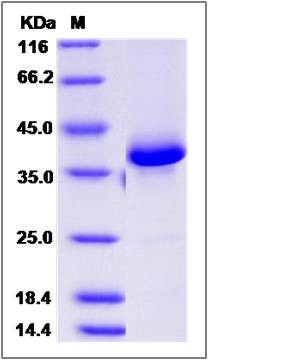Human CALCB / CGPR / Calcitonin 2 Protein (Fc Tag)
CALC2,CGRP-II,CGRP2
- 100ug (NPP1948) Please inquiry
| Catalog Number | P13283-H05H |
|---|---|
| Organism Species | Human |
| Host | Human Cells |
| Synonyms | CALC2,CGRP-II,CGRP2 |
| Molecular Weight | The recombinant human CALCB/mFc is a disulfide-linked homodimer. The reduced monomer comprises 327 amino acids and has a predicted molecular mass of 36.2 kDa. The apparent molecular mass of the protein is approximately 37 in SDS-PAGE under reducing conditions. |
| predicted N | Ala 26 |
| SDS-PAGE |  |
| Purity | > 95 % as determined by SDS-PAGE |
| Protein Construction | A DNA sequence encoding the human CALCB (P10092) (Met1-Phe118) was fused with Fc region of mouse IgG at the C-terminus. |
| Bio-activity | |
| Research Area | Neuroscience |Neurotransmission |Receptors / Channels |G Protein-Coupled Receptor (GPCR) |More GPCR |
| Formulation | Lyophilized from sterile PBS, pH 7.4. 1. Normally 5 % - 8 % trehalose, mannitol and 0.01% Tween80 are added as protectants before lyophilization. Specific concentrations are included in the hardcopy of COA. |
| Background | CALCB, also known as CGPR and calcitonin 2, belongs to the calcitonin family. CALCB is a calcitonin (CT) peptide which may play a role in the mediation of human inflammatory diseases. It is highly expressed in the skin, blood, and cerebrospinal fluid. CGRP immunolabeling (IL) was detected in epidermal keratinocytes at levels that were especially high and widespread in the skin of humans from locations afflicted with postherpetic neuralgia (PHN) and complex region pain syndrome type 1 (CRPS), of monkeys infected with simian immunodeficiency virus, and of rats subjected to L5/L6 spinal nerve ligation, sciatic nerve chronic constriction, and subcutaneous injection of complete Freund's adjuvant. Increased CGRP-IL was also detected in epidermal keratinocytes of transgenic mice with keratin-14 promoter driven overexpression of noggin, an antagonist to BMP-4 signaling. CGPR dilates a variety of vessels including the coronary, cerebral and systemic vasculature. |
| Reference |
